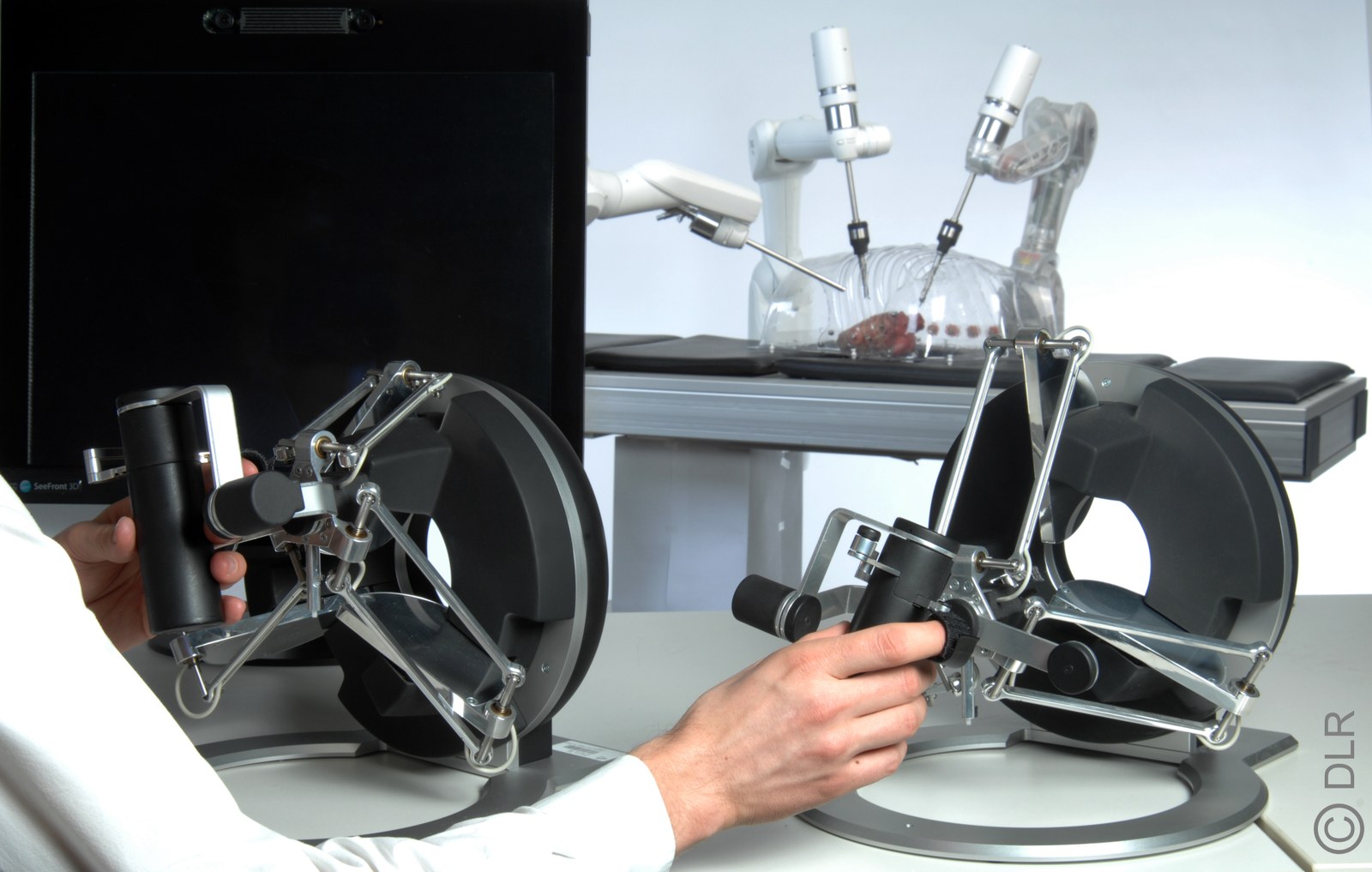MiroSurge - Telemanipulation in minimally invasive surgery

Conventional minimally invasive surgery (MIS) is performed through small incisions in the patient’s skin, preserving healthy tissue. The surgeon works with long slender instruments, and is separated from the operation area. This arrangement challenges the surgeon’s skills due to lost hand-eye-coordination and missing direct manual contact to the operation area. Therefore, many sophisticated procedures still cannot be performed minimally invasive. To overcome the drawbacks of conventional MIS, telepresence and telemanipulation techniques play an important role: In case of minimally invasive robotic surgery (MIRS) the instruments are not directly manipulated anymore. Instead, they are held by specialized robot arms and remotely commanded by the surgeon who comfortably sits at an input console. The surgeon virtually regains direct access to the operating field by having 3D endoscopic sight, force feedback, and restored hand-eye-coordination.

The DLR telesurgery scenario MIROSURGE includes an input (or master) console as well as a teleoperator consisting of 3 surgical robots (MIRO). Usually two MIROs carry surgical instruments (MICA) equipped with miniaturized force/torque sensors to capture reaction forces with manipulated tissue. One more MIRO can (automatically) guide a stereo video laparoscope. Both the stereo video stream and the measured forces are displayed to the surgeon at the master console. So users are not limited to see but can also feel what they are doing. An Omega.7 input device is used as force display.
Our ultimate ambition is robot supported surgery on the beating heart. The application of the heart-lung machine would become obsolete for a whole variety of procedures that way. Collaterally, the very traumatizing effects of the heart-lung machine on the patient could be avoided (e.g. blood contact with extrinsic surfaces, inevitable blood clotting attenuation, typical generalized inflammation reaction). Therefore, performance characteristics of the MIROs are designed to follow a stabilized beating heart motion. Additionally, the endoscopic video stream can be stabilized by optical tracking in real time so that a virtually stationary video picture can be consistently presented to the surgeon.
Projects
- MIROSURGE, funded by the Bayerische Forschungstiftung
- ACCUROBAS, a project in the 6th EU Framework Programme for Research and Technological Development
- SFB 453, Collaborative Research Centre (SFB) 453 of the DFG
Selected Publications
Hirzinger, G. and hagn, U. (2010) Flexible Heart Surgery, German Research (Magazine of the German Research Foundation DFG), 1/2010, available online
Hagn, U.; Konietschke, R.; Tobergte, A.; Nickl, M.; Jörg, S.; Kuebler, B.; Passig, G.; Gröger, M.; Fröhlich, F.; Seibold, U.; Le-Tien, L.; Albu-Schäffer, A.; Nothelfer, A.; Hacker, F.; Grebenstein, M.; Hirzinger, G. (2009) DLR MiroSurge - A Versatile System for Research in Endoscopic Telesurgery. In: International Journal of Computer Assisted Radiology and Surgery, Volume 5, (2) 2010, pages 183-193. published online Doi: 10.1007/s11548-009-0372-4, 2009
Tobergte, A.; Konietschke, R.; Hirzinger, G. (2009) Planning and Control of a Teleoperation System for Research in Minimally Invasive Robotic Surgery. In Proceedings of the 2009 IEEE International Conference on Robotics and Automation (ICRA).
Hirzinger, G., Hagn, U. (2009) MiroSurge - ein innovatives Robotik-System, Zentralbl Chir, 134(5): 397-400, DOI: 10.1055/s-0029-1241106
Konietschke, R.; Hagn, U.; Nickl, M.; Jörg, S.; Tobergte, A.; Passig, G.; Seibold, U.; Le.Tien, L.; Kuebler, B.; Gröger, M.; Fröhlich, F.; Rink, Ch.; Albu-Schäffer, A.; Grebenstein, M.; Ortmaier, T.; Hirzinger, G. (2009) The DLR Miro Surge - A Robotic System for Surgery. Video contribution presented at ICRA 2009, Finalist for best video award
Hagn, U., Nickl, M., Jörg, S., Tobergte, A., Kübler, B., Passig, G., Gröger, M., Fröhlich, F., Seibold, U., Konietschke, R., Le-Tien, L., Albu-Schäffer, A., Grebenstein, M., Ortmaier, T. & Hirzinger, G. (2008) DLR MiroSurge -- towards versatility in surgical robotics 7. Jahrestagung der Deutschen Gesellschaft für Computer- und Roboterassistierte Chirurgie e.V. Proceedings of CURAC, 2008, pp. 143 - 146
